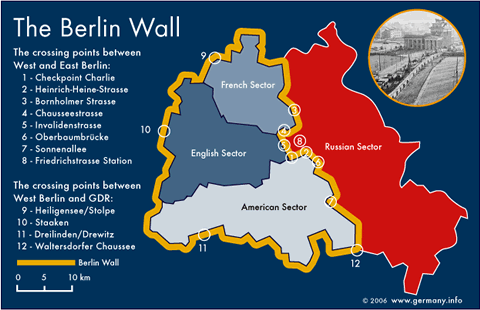
Numbers in German: how to count from 1 to 100
29 de July de 2016
Dimitris’ Diary: the lovely city of Bamberg and its breweries!
5 de August de 2016The Berlin Wall is no doubt one of the most iconic symbols of the city, not only for its general history, but for all the impacts that its existence brought to Berlin society, some of which is still present to nowadays. We list ten interesting facts about the Wall, distributed at different times in history!
1) Fictitious division in Berlin
After the end of World War II, Germany was divided into two: East Germany called “German Democratic Republic” (in German: DDR, “Deutsche Demokratische Republik”) and West Germany, called “Federal Republic of Germany” (in German: BRD,” Budensrepublik Deutschland “). Berlin, as the capital, was also subject of dispute and consequently divided into four sectors: the western side, controlled by the United States, United Kingdom and France, and the east side, controlled by the Soviet Union.
This meant that West Berlin was an “island” within East Germany!
Soon after the split, there was movement control between sectors, but also with a certain freedom. Even the subway usually operated among the sectors without any blockage. Unfortunately, this freedom decreased gradually over time.
2) Stalin tried to unify the country
The Soviet leader proposed to the leaders of the capitalist block the reunification of Germany in 1952. One of the conditions was that the reunified country could not be associated to any military alliance against the former occupants, i.e. could not position itself clearly in the Cold War.
The plan was rejected, which delayed in 37 years the reunification of the country, influenced the political dispute over the German territories and as a consequence we had the construction of the Berlin Wall. Clearly the plans of Stalin sought own interests, such as the absorption of part of the east territory by the Soviet Union.
3) Overnight, the city was divided
Erich Honecker, head of the Central Committee of the Security Secretary of the SED (“Sozialistische Einheitspartei Deutschlands”) and future leader of East Germany, commanded the soldiers to surround West Berlin with barbed wire. The episode began during the first hour of August 13, 1961 and at the morning 193 streets that made the boundary between the sectors were blocked, as well as the subway and train lines linking east and west.
The vast majority of the population, including the city’s mayor Willy Brandt, were caught by surprise.
4) Blockades and more Blockades
Several streets and subways stations were blocked after the construction of the Berlin Wall. One of the most famous episodes occurred at Bernauer Straße in Prenzlauer Berg (Pankow): it was broken in half! The wall bordered directly with some apartments, which soon became escaping route.
There are videos and testimonials that show people of all ages risking their lives by jumping from the building windows. After several attempts performed successfully, the Socialist side sealed the windows of these rooms, thus preventing more people to escape to the other side. Currently, the site is a memorial of the Wall.
5) Gorbachev asked that the wall was knocked down
The Soviet President Mikhail Gorbachev with his ministers, asked Erich Honecker that the Berlin Wall was brought down, that in 1987, two years before the fall. This request was not granted and some time later it was discovered that Gorbachev request was hidden between the notes of one of the closest employees to Eduard Shevardnadze, who was the last foreign minister of the Soviet Union.
6) Uncertain number of victims
Even today it is not certain the number of people who died trying to cross the Berlin Wall. A recent survey from University of Potsdam, points out that between 136 and 138 people were victims by shots fired by the border guards.
7) The last escape
The last victim of the period that the Berlin Wall was still standing, occurred days before the fall was announced, in November 1989. A couple organized an escape by means of a balloon. At the time of the flight, they were afraid that there was not enough air to support the weight of them both, so only the husband went.
The problem occurred when the balloon soared and reached heights of over 2,000 meters. He flew for a few hours over the city of Berlin and during landing, suffered numerous fractures that ended up costing him his life.
8) How did the fall occurred?
The fall of the Berlin Wall took place by an error of communication that caused the surprise opening of the border. On 9 November 1989, the new government of DDR tried to control the strong demonstrations demanding change. In a press conference, the then government spokesman Günter Schabowski announced that any citizen could cross the border of East Germany without prior permission.
The announcement was so surprising that, effectively, no one understood exactly what was happening. It was all about a misunderstood of the spokesman, once the new measure would only be effective from the next day on – which Schabowski did not know. He finally said that the rule would go into effect immediately: “nach meiner Kenntnis ist das sofort, unverzüglich”.
Journalists did not know what to do, but as the news was broadcast live, the Berliners understood very well what was happening. It was enough for the crowd, even before the end of the interview, to get already together in front of checkpoints in Berlin.
Unable to handle the public, the guards released the pass. It was the end of the Wall. It was undoubtedly one of the most important moments of the history of the city, not to say of contemporary history, which is remembered with great emotion by the locals.
9) The division made by the wall is visible from space
From the space it still can be seen the old political division of Berlin. This is possible because West Berlin has one of the highest concentrations of gas lamps, which represents 50% of all lamps of this kind in the world. This type of lighting contrasts with the rest of the city, making it possible to distinguish each of the regions.
10) The dispute between Berlin and the artists of the East Side Gallery
After a major restoration carried out in 2009, some artists of the “East Side Gallery” (i.e., the portion of approximately 1.3 km of the still-standing wall that was transformed into an art gallery) announced that they would move lawsuit against the city of Berlin for copyright infringement. This is because they claim that the city would have destroyed the original works and copied again during the restoration stage, without the permission of the artists. The result of this process will certainly be a landmark in European art laws.
Sources: http://www.pragmatismopolitico.com.br/2014/11/25-curiosidades-sobre-o-muro-de-berlim.html and http://g1.globo.com/mundo/noticia/2014/11/veja-25-fatos-sobre-o-muro-de-berlim.html





